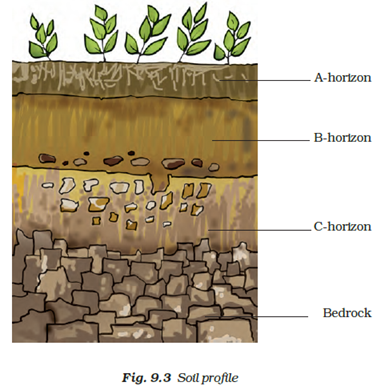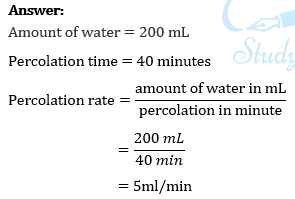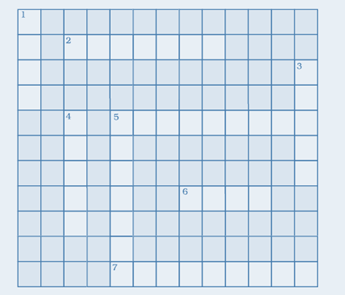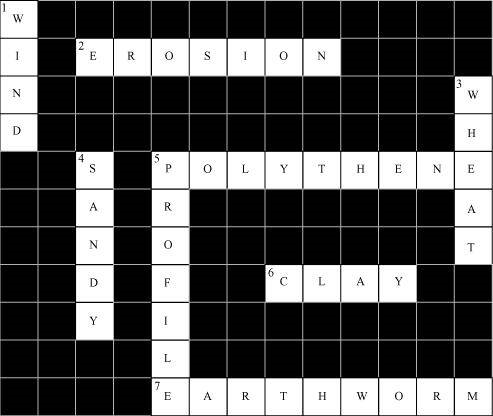NCERT Solutions for Class 7 Science Chapter 9 Soil
NCERT Solutions for CBSE Class 7 Science Chapter 9 Soil are given below. These solutions help students to clear their doubts and to obtain good marks in final exam. Class 7 Science NCERT questions and answers provided in this article are strictly based on the CBSE syllabus and curriculum.
Class 7 Science Chapter 9 Soil NCERT Solutions
Class 7 NCERT Solutions for Science Chapter 9 includes all the intext and exercise questions. All these questions are solved by experts with a detailed explanation that will help students complete their assignments and homework.
Exercises
Tick the most suitable answer in question 1 and 2.
Question 1: In addition to the rock particles, the soil contains
(i) Air and water
(ii) Water and plants
(iii) Minerals, organic matter, air and water
(iv) Water, air and plants
Answer: (iii) Minerals, organic matter, air and water.
Question 2: The water holding capacity is the highest in
(i) Sandy soil
(ii) Clayey soil
(iii) Loamy soil
(iv) Mixture of sand and loam
Answer: (ii) Clayey soil
Question 3: Match the items in Column I with those in Column II:
| Column I | Column II |
| (i) A home for living organisms | (a) Large particles |
| (ii) Upper layer of the soil | (b) All kinds of soil |
| (iii) Sandy soil | (c) Dark in colour |
| (iv) Middle layer of the soil | (d) Small particles and packed tight |
| (v) Clayey soil | (e) Lesser amount of humus |
Answer:
| Column I | Column II |
| (i) A home for living organisms | (b) All kinds of soil |
| (ii) Upper layer of the soil | (c) Dark in colour |
| (iii) Sandy soil | (a) Large particles |
| (iv) Middle layer of the soil | (e) Lesser amount of humus |
| (v) Clayey soil | (d) Small particles and packed tight |
Question 4: Explain how soil is formed.
Answer: Soil is formed due to the weathering of rocks. Weathering is a process in which physical breakdown and chemical decomposition of minerals takes place primarily by wind, water and climatic changes. In the weathering process, rocks are converted to small pieces, which eventually turn to soil particles to form a layer of soil.
Question 5: How is clayey soil useful for crops?
Answer: Clayey soil is useful for crops for the following reasons
- It has excellent water holding capacity
- Clayey soil is rich in organic matter
- Clayey and loamy soils are suitable for growing cereals like wheat.
- Water holding-capacity of clayey soil supports the growth of crops like paddy which require more water to grow.
Question 6: List the differences between clayey soil and sandy soil.
Answer:
| Clayey soil | Sandy soil |
| The proportion of fine particles is higher. | The proportion of large particles is higher. |
| Particles are packed tightly. | Particles are loosely packed. |
| It can hold good amount of water. | It’s ability to retain water is low. |
| Water cannot drain quickly. | Water can drain quickly. |
| It is heavy in weight. | It is light in weight. |
| Less air is trapped between the particles. | More air is trapped between the particles. |
| It is rich in humus. | It is not rich in humus. |
Question 7: Sketch the cross section of soil and label the various layers.
Answer:

Question 8: Razia conducted an experiment in the field related to the rate of percolation. She observed that it took 40 min for 200 mL of water to percolate through the soil sample. Calculate the rate of percolation.

Question 9: Explain how soil pollution and soil erosion could be prevented.
Answer: Prevention of Soil Pollution:
- Use manures instead of chemical fertilizers.
- Industrial waste should be treated before release.
- Avoid use of polythene and plastic or they should not get mixed in soil.
Prevention of Soil Erosion:
- Afforestation: large scale planting in place of cut down forests.
- Avoiding over-grazing of grass lands.
- Use of step-farming in hill regions.
Question 10: Solve the following crossword puzzle with the clues given:

Across
2. Plantation prevents it.
5. Use should be banned to avoid soil pollution.
6. Type of soil used for making pottery.
7. Living organism in the soil.
Down
1. In desert soil erosion occurs through.
3. Clay and loam are suitable for cereals like.
4. This type of soil can hold very little water.
5. Collective name for layers of soil.
Answer:

Across:
2. Erosion
5. Polythene
6. Clay
7. Earthworm
Down:
1. Wind
3. Wheat
4. Sandy
5. Profile